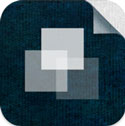Layover
Version reviewed: 1
Price: $0.99
![]()
Bottom Line: I like it. It’s a good start, but several features and tools still need a few tweaks.
 There are several photo apps that support a layers workflow — some better than others. Layover by Peak Systems, the developer behind the excellent Diptic app, is not a what to do at the airport travel app, but a fairly easy to use but powerful layering, blending and compositing app. You can do some cool production with it! It’s not perfect yet, but version 1 is pretty good.
There are several photo apps that support a layers workflow — some better than others. Layover by Peak Systems, the developer behind the excellent Diptic app, is not a what to do at the airport travel app, but a fairly easy to use but powerful layering, blending and compositing app. You can do some cool production with it! It’s not perfect yet, but version 1 is pretty good.
Layover lets you blend, mask and composite up to five images. Importing and deleting images is easy and intuitive. Rearranging the order of layers is drag and drop easy. Layers also retain their blend mode as you reorder them. Layers are easily deleted by a Tap and hold the layers palette to bring up the familiar red minus sign. The layers are really well done and work the way you expect them to — add images, work, blend, move around if needed. Pretty simple.
The app has three tools menus — Crop, Blend, and Mask. Their function changes depending on the current task of the app. For instance, the Crop tool lets you choose between the default Square canvas or the fixed ratio 4:3 or 3:2 ratios. You can choose between landscape and portrait modes.
Blend lets you set the blend style of the overlay. There are 15 blend effects. Anyone who uses Photoshop will feel right at home using Multiply, Screen, “overlay”, and other standard blend modes which give you many more options than just the simple opacity slider many other apps have. When applied to the bottom layer, however, the Blend tool becomes an RGB color palette that also lets you add a base color you could use in lieu of a photo. Unfortunately, the three color bars lack 0-256 value indicators so creating a precise color from a known RGB mix is almost impossible.
Layover’s Mask tool lets you erase specific parts of pictures to isolate different elements, remove the background, let different layers show through. You can use the Mask tool along with the Blend modes to get some interesting isolated effects. The Mask slider controls the opacity of the brush. It’s a good sized, general use brush with a slightly soft edge for natural-looking masks. By tapping the eye in the upper left corner, you can hide all the menus for distraction-free editing. That’s a helpful detail to get screen clutter out of the way for delicate edits.
To help created a detailed mask, you can use the Mask tool’s temporary zoom feature by carefully pinching out with two fingers. It’s a welcome feature, but it’s not implemented well. It’s cranky and didn’t react to my two-finger gestures all the time, dotting my masks with little unintended holes. Also, the brush size stays the same relative to the image, not the screen. That means you’re painting out a mask with the same general use brush, only now it’s bigger onscreen. Temporary zoom only previews the active layer, leaving the other layers at their original size. This was confusing to me the first few times I used the tool until I realized that switching to any other tool snaps the zoomed layer back to original size as well. That’s cool, but the temporary zoom needs improvement.
The Mask tool has an Undo button, but use it carefully. It deletes all edits to your mask, not just the most recent and there’s no Redo button. This is a pretty big omission considering how most Undo buttons in other apps behave. This needs to be fixed. Unlike Artifact, another dedicated layers app, there’s no way to control the size, shape or hardness of the brush in the Mask tool. Despite the app’s focus on simplicity, the lack of brush size and hardness is another significant omission. There’s no New Canvas button. To start from scratch, the easiest way to clear the layers is to completely quit out of the app. Clunky.
Layover supports up to 2048×2048 px square format saves — a respectable 4 MP. For Standard 4:3 images, it saves at 2048×1536 px — the same 3.2 MP resolution of an iPhone 3GS. You can still get some good enlargements from them. Most EXIF data is not preserved.
The app supports Apple’s Open In… protocol. That’s a great feature that I like a lot. You can send your finished work directly to Photogene2, pxl, Picfx and other photo apps that support the feature, completely bypassing your camera roll.
Layover as a layering tool gets a lot right. It’s easy to use. I like how it supports up to five images for blending and compositing. It’s got nearly all of Photoshop’s blending modes. The layers, blends and masks work like Photoshop better than nearly all other layer apps. Workflow is smooth and fast. Resolution is not full, but definitely high enough for most uses. But it’s definitely a 1.0 version and there are still a few kinks to be worked out. It’s a good start, but Layover hasn’t arrived yet. All it needs is a few tweaks.
Layover is $0.99 in the App Store. It’s a Universal app and is designed for both iPhone and iPad. Requirements: Compatible with iPhone 3GS, iPhone 4, iPhone 4S, iPod touch (3rd generation), iPod touch (4th generation) and iPad.Requires iOS 5.0 or later.
=M=
..
~~~~





